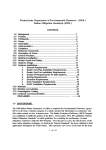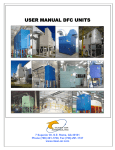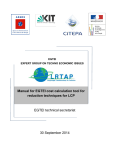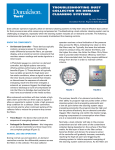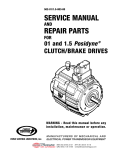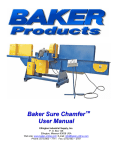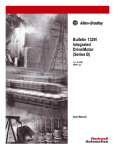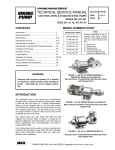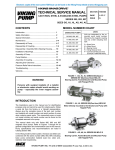Download View Acrobat Installation & Service Manual
Transcript
Installation and Service Manual for Horizontal Cartridge Filtration Systems Installation & Service Manual for Horizontal Cartridge Filtration Systems MODELS HCF-3000 HCF-3030 HCF-3050 February 10, 2003 InstallationTABLE andOFService Manual for CONTENTS Horizontal Cartridge Filtration Systems Page Subject 2 ................................................ Table of Contents 3 ................................................. Disclaimer 4 ................................................. Uncrating 4 ................................................. Description & Operation 4 ................................................. Optional Equipment 5 ................................................. Applications/General 6-9 ............................................. Installation 7 ................................................. Figure 1 Motor & Trans. Connection Diagram 8 ................................................. Figure 2 Control Timer 10 .............................................. Parts List 11 .............................................. Maintenance 12 .............................................. Troubleshooting Chart 13 .............................................. Specifications 14 .............................................. Warranty 2 Installation and Service Manual for Horizontal Cartridge Filtration Systems DISCLAIMER: Although instructions and recommendations are included for installation of your Horizontal Cartridge Filtration System, the manufacturer does not assume responsibility for the installation of this equipment nor shall he be held liable for direct or consequential damages resulting from improper installation, application, maintenance or use. The immense variety of contaminants make it impossible to list all of the potential hazards that may be encountered with air pollution control systems. It is therefore important that the application of the equipment be discussed with an AER Control Systems representative or application engineer prior to use. Additionally, users should consult and comply with all National and Local Fire, Electrical and /or other appropriate codes when determining the application, location and operation of any air pollution control equipment. Collection of combustible or explosive materials and collection on flame or spark-generating operations may require specific system configurations (contact AER Control Systems LLC. Applications Engineering Department for questions and/or design assistance). The combined collection of combustible or explosive materials and contaminants from spark or flame generating operations, with a common collector or duct system, is not recommended, unless special design provisions have been made to the system (sparks or flames resulting from such operations may ignite the combustible or explosive material). Under no circumstances should anyone be allowed to discard a lighted cigarette, other burning materials, or refuse into an inlet hood or the duct of the collection system. It is the responsibility of the end user to comply with all applicable national, state, and local fire and safety codes. This manual should be read completely before attempting Operation or Maintenance of this equipment. All work should be performed by qualified personnel according to local requirements. WARNING Failure to comply fully with the following instructions and local code requirements may increase your risk of physical injury due to fire, explosion or electrical shock. All data and dimensions in this manual have been thoroughly checked however, we cannot assume responsibility for possible errors or omissions. We reserve the right to change designs and/ or specifications without notice. 3 Installation and Service Manual for Horizontal Cartridge Filtration Systems SECTION 1 UNCRATING 1. Remove banding and cardboard shipping carton and packing. 2. Hoppers, plenum boxes and attenuators are typically labeled and packed with the unit but not installed. Mounting hardware is included for mounting these items, be sure to check all boxes for any miscellaneous parts or hardware items before discarding. 3. Inspect the exterior of the unit and accessories for shipping damage or shortages that may not have been noticed or recorded when the shipment was initially received; contact the shipping company if any damage or shortages have occurred. Description & Operation The HCF series collector consists of a horizontally mounted filter module which house the cartridge filters. Each cartridge has a filter media pack of 2 inch pleated media with a filter surface area of 240 sq. ft. and is formed in the shape of a hollow cylinder. The interior of the cartridge cylinder is open to the pulse tank module, which periodically cleans the cartridges by compressed air, pulse jet flushing. Diaphragm valves are mounted to a compressed air reservoir tank and activated by a solenoid valve. During operation a short blast of compressed air to the interior of one bank of filters results in media vibration and airflow reversal that back flushes collected contaminants off of the exterior surface of the filter bank. By alternating the compressed air cleaning of the filter banks, the system can continue to collect contaminants while cleaning takes place. The motor/blower module is located on the clean air side of the system after the pulse tank module and provides airflow for the collection system. Optional Equipment Special Filters Motor Starters Delay Pulse Timer Drum Kit Mechanical Arms Attenuators 4 Mounting Brackets & Stands Photohelic On Demand Pulse Installation and Service Manual for Horizontal Cartridge Filtration Systems SECTION 2 APPLICATIONS - GENERAL 1. Dust & Fume - The Horizontal Cartridge Filtration System (HCF) is designed for the capture and removal of DRY dust and/or fumes generated from sanding, grinding, welding and other industrial processes. The HCF cartridge collector is a modular system consisting of a filter media/cartridge filter module, collection hopper and a final module containing the air reservoir tank and pulse-jet cleaning system, blower and motor. The unit can be arranged in a variety of configurations and can be equipped with specialized filters for application specific filtration requirements. The ceiling or wall-mounted collectors can be used for direct ducted, source capture applications or as free hanging, un-ducted, ambient collectors for removal of general airborne contaminants. 2. Size - It is important that the proper size unit has been selected for the application. Too little airflow will not draw the contaminant into the filter and the unit will not be completely effective. Too much airflow may result in loss of efficiency or the unit will pick up large or heavy solid particles increasing the frequency of maintenance or filter replacement. Questions regarding proper unit sizing should be directed to your local AER Control Systems representative or the main office (toll free 866-2652372). 3. Models - Model codes are utilized to identify the various unit configurations available. The model HCF (Horizontal Cartridge Filtration) system uses a direct drive blower (sometimes called a plug fan) along with the number 3000, 3030, or 3050. The 3000 unit is designed to be a un-ducted, horizontal ambient collection system for control of airborne contaminants in the general room. The remaining units are designed for direct ducted, source capture applications. The 3000 and 3030 units have a 3 HP direct drive motor and fan, and the 3050 unit has a 5 HP direct drive motor and fan. 4. Drum Kits - Drum kits are available for connection to the hopper on the Horizontal Cartridge Filter unit for storage of removed contaminant. 5. Collars & Inlet Plenums - Ducted source capture units are provided with inlet collars and or inlet plenum boxes for attaching ductwork or for direct mounting of mechanical arms. 5 Installation and Service Manual for Horizontal Cartridge Filtration Systems SECTION 3 INSTALLATION Assembly & Installation HCF-3000, HCF-3030 and HCF-3050 * Standard collectors are shipped without hoppers installed (mounting hardware is included). Installation consists either of ceiling, wall, or column mounting. Weld nuts for permanent mounting (bolt to frame or hang with threaded rod) are welded in the corners of each module on the top of the cabinet. Eye bolts for lifting, assembly and mounting are provided (Mounting kits available). * The hopper has an 7 7/8 in. O.D. outlet collar, which should be connected to a 55 gallon drum or similar storage container by a flexible hose or clamp duct (steel drum kits with flex hose are available from AER Control Systems LLC.). It is critical that the cover of the drum or container is fastened in place and has an airtight fit to avoid leakage and reentrainment of collected dust. A liner can be placed in the drum to allow for easy disposal of the collected dust (flame retardant liner or no liner suggested for applications that generate sparks). Assembly & Installation All Models * The integral junction box is factory wired for 460 volts 3 phase (unless otherwise specified on the purchase order) requiring only a qualified electrician to connect input power to the unit. Suitable over load protection such as a motor starter is required. Refer to the electrical section. (Combination motor starters with fusible disconnect packages are available through most local AER Control Systems LLC. distributors). • A connection for clean, dry, compressed air is located outside the pulse tank module and connected to the air reservoir tank. A 120-PSI relief valve to prevent tank over-pressurization and a condensate drain (check periodically) are provided and are pre-connected to the reservoir tank. The supply airline should be purged to remove any debris before connecting it to the unit to prevent damage to the pulse valves on the system. The supply compressed air line should be equipped with a manual shut-off valve, a filter/separator, air regulator, and a pressure gauge and located close to the HCF system. If the unit is to be installed in an area where freezing temperatures or high humidity are to be expected, an air dryer capable of drying the compressed air to below the dew point must also be provided. If excessive moisture is present, check condensate drain frequently or install an automatic drain. 6 Installation and Service Manual for Horizontal Cartridge Filtration Systems SECTION 3 INSTALLATION (continued) Electrical All three-phase units are wired for the input voltage specified on the purchase order. Unless specified otherwise, standard units are wired for 460 volt, 3 phase, 60 Hz operation. Motors used on the HCF collectors are UL recognized and internal wiring is UL rated at 600-volts. Input power line protection is required for the motor and electrical components. Line load and current requirements are identified on the motor nameplate. Unless ordered with the machine, the power switch for operating the machine, any fusible disconnect, motor starter or controller are to be provided by the customer/user and located externally to the machine. After electrical hook up it is important to verify that the fan rotation is correct. Incorrect rotation results in much lower airflow and increased noise. For standard three phase installations, changing connections of any two of the three input power lines will usually reverse fan rotation. Rotation direction can be found on the side and/or back of the motor. If it becomes necessary to change the input voltage, the wiring diagram on the motor and transformer nameplates show the appropriate wire connections - these diagrams are also shown below: Figure 1: Motor & Transformer Connection Diagram 7 Installation and Service Manual for Horizontal Cartridge Filtration Systems FIGURE 2: Control Timer 8 Installation and Service Manual for Horizontal Cartridge Filtration Systems SECTION 3 INSTALLATION (continued) Control Systems AUTOMATIC CONTROLS include an integrated, electrically operated pilot solenoid valve for each diaphragm valve. The solenoid valves are controlled by a solid-state sequential control timer that determines the order in which the solenoid valves are operated, the length of time that the valves remain open, and the time interval between each valve opening. The compressed air tank and valves are fully enclosed and located between the cartridges and the blower. The sequential control timer, input power connection, transformer and indicator light are contained in the electrical box mounted on top of the unit. WARNINGS Take special care when the electrical box is opened. When power is ON, the full line voltage can appear from any electrical point on the circuit board to the metal enclosure or to ground. Compressed Air Requirements Air reservoir pressure should be set between 90-psig (the minimum pressure which will assure truly effective cleaning of the cartridges) and 105-psig (the maximum recommended working pressure of the valves and air reservoir). Note: The air reservoir system has a 120-psig-relief valve. The total consumption of compressed air is variable and is dependent upon the set points of the ON and OFF time of the timer and the air pressure in the reservoir at the time of the air pulse. When the ON timer is set at its recommended time of 0.1 second and the air reservoir pressure is at 100-psig, approximately 0.9 cubic feet of free air will be used per pulse. While the cartridges are being cleaned, the average usage rate in CFM of free air depends upon the setting of the OFF timer. If set at 30-second intervals (2 pulses per minute) the average usage rate during a cleaning cycle would be (0.9 cu. ft./pulse) x (2 pulses/minute) = 1.8 CFM of free air. 9 Installation and Service Manual for Horizontal Cartridge Filtration Systems SECTION 4 Ordering Replacement Parts Information required for prompt delivery of replacement parts will be: 1. 2. Model and Serial Number Part Number and Description Contact your local AER Control Systems LLC. distributor for replacement parts. Use our toll free telephone number to obtain the nearest AER Control Systems LLC. distributor's name and telephone number. 1-866-265-2372 Part Number Description QTY HCF-3000 HCF-3030 HCF-3050 1015-02 Blower Inlet Cone 12 inch 1 1 - 1015-04 Blower Inlet Cone 15 inch - - 1 1012-01 Blower Impeller Wheel, 12”-100% 1 1 - 1013-02 Blower Impeller Wheel, 15”-53% - - 1 1003-15 Motor, 3 H.P. 1 1 - 1003-17 Motor, 5 H.P. - - 1 1041-05 Cartridge, One End Open 2 2 2 1041-07 Cartridge, Both Ends Open 2 2 2 1218-03 Diaphragm/Solenoid Valve 1” 2 2 2 1220-01 Control Timer Board 1 1 1 1089-01 Pressure Relief Valve 1 1 1 1233-11 Transformer, 50 Watt 1 1 1 1224-22 1 Amp Fuse 2 2 2 1224-18 1/2 Amp Fuse 1 1 1 1221-01 Delay Relay Timer (optional) 1 1 1 1084-01 Louvre - Exhaust, 14 x 8 1 1 1 10 Installation and Service Manual for Horizontal Cartridge Filtration Systems SECTION 5 MAINTENANCE Operation & Maintenance Lubrication or other routine periodic preventative maintenance is not required. All that is needed is an occasional check of fasteners, hoses and clamps and a general visual check of the unit to make sure that nothing has gone wrong. Periodic replacement of the cartridges is required when necessary and check/draining of condensation from air reservoir. Draining can be done automatically if the drain is opened (slowly) while the tank is under pressure. Always empty the dust storage drum before it fills completely. Do NOT allow the dust to collect to the point where it begins to fill the flexible hose and enter the bottom of the hopper, since this would result in the dust being re-entrained in the air stream, re-depositing on the cartridges and shortening their life. Do NOT use the hopper as a dust storage device! Cartridge Replacement HCF-3000, HCF-3030 and HCF-3050 The pressure drop across the cartridges will eventually reach a point at which the airflow and suction are too low. At this time, the cartridges should be replaced as follows: 1. Shut off electrical power to the blower and control box. 2. Open the cartridge access doors on the end of the filter cartridge module. 3 Turn the ball handle knob counterclockwise to release the tension on the doors, each door has a filter compression spring which pushes against the cartridge to seal the cartridge against the tube sheet. Once the knob is loosened the door retainer bar can be rotated and the doors can be swung open and the filter cartridges can be accessed. 4. Cartridges may be easily removed for inspection or replacement. 5. Reinstall cartridges noting that the cartridge filter that is open at both ends is inserted sealing gasket first (HCF-3000, HCF-3030 and HCF-3050) into the cabinet. The cartridge with one end capped is assembled so that the closed end is at the door end of the cabinet and compressed by the filter compression spring. 6. Make certain that the edge of the cap does not hang up on the cabinet opening. 7. Close the cartridge access doors and retighten the ball handle knob until doors are fully sealed against cabinet. 11 Installation and Service Manual for Horizontal Cartridge Filtration Systems Troubleshooting Problem Motor fails to start Low airflow and/or suction Contaminant blowing out of collector exhaust Cause Solution No power to unit (indicator light is not lit) Check overload heaters in starter and fuses and replace or reset if necessary. Check for proper wire connections to and from the starter and collector. Power to unit (indicator light is lit) Check wires from input electrical box on collector to motor. Check motor wiring. Check to see if motor is faulty. Blower is running backwards Check rotation of blower. If running backwards, interchange 2 of the 3 input power leads (3 phase motors only) Cartridges are not being cleaned Check air pulse system to determine if it is working properly. Check air pressure. Obstruction in ducting Check ducting for blockage. Check for dampers in the duct system, they may be closed. Improper duct design. Hole in cartridge. Replace Cartridge. Cartridge not properly installed Check for correct cartridge orientation. Check cartridge gasket, gasket must seal around hole in tube sheet of cartridge cabinet. Check cartridge access door, knob should be tight for proper door and filter sealing. Unit is not pulsing, but motor is No power to timer board running Check for blown fuses. Replace if necessary. Check transformer. Power is getting to timer board Check to see if compressed air is on. Check wiring from board to valve assembly. Check to see if valves are opening. Unit is not pulsing, but motor is Not set properly running (units with delay timer or Photohelic pulse option) Check timer set points. Off time may set for a longer period than you expect. Check high and low pressure set points on Photohelic. High-pressure set point may be set too high. Unit pulses all the time Check timer board settings. Timer board is designed for pulse intervals every 8.5 seconds to 3 minutes. Off time set to short Set times on Photohelic option are not High pressure and/or low pressure set properly set. points may be set too low. 12 Installation and Service Manual for Horizontal Cartridge Filtration Systems Specifications SPECIFICATIONS HCF-3000 HCF-3030 HCF-3050 Nominal Airflow-CFM 3000 2000 2000 Available External Pressure - In. H2O N/A 1.0 5.0 4 4 4 960 960 960 Motor - HP 3 3 5 Motor Temp. Max - C 40 40 40 Filters - Quantity Total Filter Area Sq. Ft. 90 to 105 PSIG Compressed Air 1 Tank Qty. 0.32 Cu. Ft. Tank Volume 1 in. Diaphragm Valve (2) Program Timer: off time on time Solid state: 8.5 to 180 sec. 0.05 to 0.50 sec. Input Power 110 VAC, 60 Hz., 1 Phase Plug Fan Plug Fan Plug Fan Single, Ambient 2 Std. up to 4 avail. 2 Std. up to 4 avail. 12 inches 12 inches 15 inches N/A N/A N/A Speed 3450 RPM 3450 RPM 3450 RPM Drive Direct Direct Direct 3.0 3.0 5.0 3450 3450 3450 190/380//230/460 190/380//230/460 190/380//230/460 50/60 50/60 50/60 3 3 3 Frame - NEMA 56C 56C 184TC Power Factor 89% 89% 92% 82.5% 82.5% 87.5% Start Current Amps (60 Hz.) 65.8/33.9 65.8/33.9 112/56 Full Load Amps (60 Hz.) 8.1-7.6/3.8 8.1-7.6/3.8 13-12/6 F F B TEFC TEFC TEFC Service Factor 1.15 1.15 1.15 Duty Cycle Cont. Cont. Cont. Blower/ Motor Type Inlet Wheel Diameter Outlet Area HP Speed RPM Voltage Frequency Hz Phase Efficiency Insulation Class - Min. Enclosure Bearing Grease Specification Exxon POLYREX®EM Exxon POLYREX®EM UL & CSA Approved 13 UL & CSA Approved Exxon POLYREX®EM UL & CSA Approved LIMITED WARRANTY AER Control Systems LLC warrants all products sold only to purchasers for use in business or for resale, against defects in workmanship or materials under normal use, for one (1) year after the date of purchase from AER Control Systems LLC. Misapplication of the product, decomposition by reaction or chemical action and wear caused by abrasion will not constitute, or be considered as a defect. Warranty is void if the product has been subject to damage, unreasonable use, neglect, improper service, improper installation or other causes not arising from defects in original material or workmanship. Any part that is determined to be defective in material or workmanship and returned to an AER Control Systems LLC distributor or authorized service facility, as AER Control Systems LLC designates, shipping cost prepaid, will be, as the exclusive remedy, repaired or replaced at AER Control Systems LLC's option. AER Control Systems LLC shall not be liable for any incidental or consequential cost, expenses, or damages resulting from any failure, defect or malfunction of this product, liability is expressly disclaimed. AER Control Systems LLC's liability in all events is limited to and will not exceed, the purchase price of the product. Title and risk of loss pass to the buyer on delivery to the common carrier. If a product is damaged in transit, the recipient MUST make note of the damage on upon receipt of the product and file a claim with the carrier. AER Control Systems LLC will make a good faith effort for prompt correction or other adjustment, with respect to any product that proves to be defective within the warranty period. Collection of combustible or explosive materials and collection on flame or spark-generating operations may require specific system configurations (contact AER Control Systems LLC. Applications Engineering Department for questions and/or design assistance). The combined collection of combustible or explosive materials and contaminants from spark or flame generating operations, with a common collector or duct system, is not recommended, unless special design provisions have been made to the system (sparks or flames resulting from such operations may ignite the combustible or explosive material). Under no circumstances should anyone be allowed to discard a lighted cigarette, other burning materials, or refuse into an inlet hood or the duct of the collection system. It is the responsibility of the end user to comply with all applicable national, state, and local fire and safety codes. AER Control Systems LLC. Incorporated liability for consequential and incidental damage resulting from a fire or explosion is expressly disclaimed. Installation of suitable overload protection such as a motor starter, according to NEC guidelines, is required. Failure to provide proper overload protection will void warranty coverage on electrical components in the system. (Combination motor starters with fusible disconnect packages are available through your local AER Control Systems LLC. representative). To ensure optimum collector performance always use AER Control Systems replacement filters.














